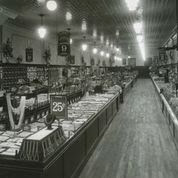By Anne Dealy, Director of Education and Public Information
Geneva, like most of
American society, was gradually but completely transformed between the
post-Civil War period and the early 20th century from an agrarian
and somewhat homogenous village into a much more diverse, industrialized, and
wealthy city. This transformation led to political and cultural shifts that
challenged long-standing ideas about identity, work, gender, religion, and
family roles. One of the most significant changes that clearly emerged by the
1910s and 1920s was the shift to a modern consumer culture. Whereas in the
past, most Americans had defined themselves by religious, work and family
roles, by the 1920s Americans were increasingly demonstrating their values and
identity through the things that they owned.
 |
| Buick markets its 1923 sedan as a car for a woman and her children. |
Technological advances,
improvements in productivity, and innovations in financing combined with the
development of mass media to create this mass culture. The prosperity of the
1920s led to an explosion of consumer goods available even to people of modest
means. Household products and conveniences that were developed in the late 19th
century and used by wealthy Americans became cheaper and began to spread down
the economic ladder. As production increased, companies had to figure out how
to sell their products to more and more people. Marketing and advertising
became major components of national businesses. Newspapers and magazines were
the preferred way to reach people. Then, as now, marketers believed that women
were the major consumers of household products, and so, many goods were
marketed to them, even those not originally considered to be of interest to
women.
 |
| There was no shortage of stuff to buy in |
Genevans participated in
this new economy, both as consumers and as producers. New retail shops opened
in town to sell automobiles, phonographs, radios, electrical and heating
equipment, furniture, cameras, sporting goods, clothing, food, typewriters and
vacuum cleaners. Among the many goods manufactured by Geneva
 |
Houses in local 1920s real
estate listings boasted modern conveniences like electricity, bathrooms,
garages, paved streets and steam heating. The long list of contractors
indicates that there was a strong market for building and redecorating houses,
as people added wiring, central heating and plumbing.
 |
| Local and national advertisements featured modern, “sanitary” bathrooms. |
National women’s magazines
advertised stoves, kitchen cupboards, bathrooms and cleaning products to make
the home safer, more efficient and pleasant. Women in the upper class and
growing middle class no longer had to spend the whole day doing food
preparation and housework. They were free to pursue other activities—joining
women’s clubs and lending a hand to church charities, the suffrage movement and
the prohibition lobby. People spent more time reading, eating out, playing
sports, listening to the radio, and going to the movies.
Advertisers stressed how
their products saved time and money, appealing to housewives’ interest in doing
things other than housework. Efficiency and organization, which had
revolutionized factory production in the 1910s, were applied to the household.
Professionals in the new field of home economics worked with manufacturers to
bring efficient and sanitary principles to the home.
 |
| Advertisers sold the idea that a modern kitchen was a healthier and more efficient one. |
Marketers also had
solutions for those who aspired to consume the latest goods, but had less
money. Products like linoleum were sold as durable and cheap alternatives to
more expensive rugs or patterned hardwood floors. Hats could be dyed or
refreshed with a coating that made them look new. Payment plans allowed people
to buy on installment. A woman could sew her own dress in the latest styles of Paris
 |
| Advertisers prompt Americans to keep up with fashion on a budget. |
Although it would slow
consumption down for a decade, even the Great Depression could not stop the
American desire to buy. Kresge’s (now Kmart), which opened just as the
Depression began, survived the contraction, as did most other Geneva


No comments:
Post a Comment